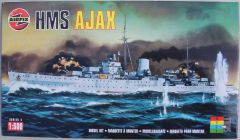

 |
Type 11 box. If you look carefully, this painting has been reversed! |
Unfortunately, one of the four propeller screws was missing. A quick email to Rita at the Airfix spare parts department, had the missing part on my doorstep in a couple of weeks, free of charge. Apparently, Rita handled 10,000 requests per year! She went into retirement when Airfix were forced into administration in August 2006. Hopefully Hornby, the new owners of Airfix, will continue this service. The parts are moulded in the standard soft grey plastic, which are gentle to the old moulds and make correcting any imperfections a little easier. There were some sink marks on the turrets and funnel, but other than that, the parts were fairly clean. There was very little flash.
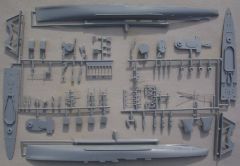 |
The parts come from one large sprue. |
I also bought the White Ensign Models photo-etch detail set. Along with the standard handrails and hatches, you also get parts for the Seafox, catapult, crane, quad 0.5" machine guns, and other detail parts. I always thought that my first ship models looked bare without handrails and I wondered back in the 1970s how this could be done. Thanks to the wonders of photoetch, we now have an ability to recreate this detail. I think it makes a huge difference to how the finished model looks.
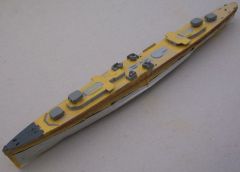 |
Masking of the decks before painting the walls. |
The fore and aft decks were then glued on, the edges filled and sanded, and then resprayed with satin oak. Some PE doors were added and the walls and deck details painted H64 Matt Light Grey. The foredeck was painted H27 Sea Grey. While all this was happening, I was building the bridge, funnel, catapult, Seafox, crane, quad 0.5" guns, foremast and aftmast. These all used various bits of PE. You can go mad building the quad 0.5" guns, as they each consist of seven very tiny pieces! It makes me wonder how the 1/700 ship builders manage. The PE makes a huge difference to the crane, catapult and Seafox. I added a short piece of plastic rod to the base of the crane, so that it could move up and down. For the funnel, I added lengths of plastic rod to the front, to make it look a bit more accurate. The WEM instructions have the girders under the funnel searchlights going out, whereas the photos I have seen have the girders going towards the funnel. I did not use the PE parts for the accomodation ladder, as I did not find any photos of HMS Ajax using this.
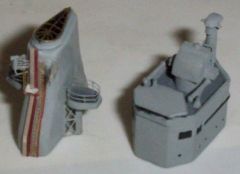 |
Bridge and funnel. |
The WEM instructions state that the Seafox at the Battle of the River Plate had Dark Sea Grey/Dark Slate Grey over Sky camouflage. However, there is a photo of HMS Ajax's Seafox apparantly taken around the time of the battle, showing the Seafox in doped aluminium, with the front part of the tail black. Here are two closeup photos of K8582 which was carried by HMS Ajax. The tail of the Seafox had the HMS Ajax crest. The engine was painted H129 US Gull Grey to represent Cerrux Grey. I measured the Seafox in the kit where I found it to be about 1/530 scale, about 13% larger than what it should be. Using my ALPS printer, I made decals for the Seafox, including the serials and crest! The decals also include windows for the motorboats. You can download these decals from here.
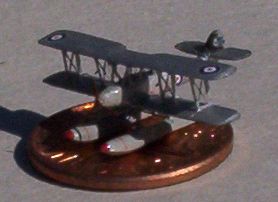 |
The Seafox is resting on a US one cent piece! |
The top decks were then all masked up for the top of the hull to be spray painted with H64. The portholes were then painted H21 Gloss Black using a 20/0 brush. I couldn't be bothered drilling all the portholes and filling with clear drying white glue. This looked pretty good and was easy to do. The top of the hull was masked and the bottom of the hull sprayed H70 Brick Red. The bottom hull was masked, leaving 1 mm space for the boot topping, which was brush painted with H33 Matt Black. The boot topping was then masked, so that I could handle the ship while fitting the rest of the parts.
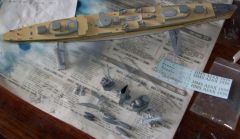 |
Railing starting to be added, subassemblies below and ALPS decals to the right. |
The deck masking was removed, which was followed by superglueing the handrails. This was sometimes a tricky operation, as the handrails are fairly delicate and can be easily bent. The major assemblies were then glued in place. These were the bridge, funnel, fore and aft mast. Next step was rigging. I used Aeroclub stretch thread which worked a treat. It didn't work so well between the masts, as they were pulled towards each other. I cut off the thread, and stuck very thin rod in its place.
The rest of the small parts, like the quad 0.5" guns, flagmasts, catapult, Seafox, and crane were added. The hull masking was removed and the PE anchors and propellers glued in. These parts were painted H54 Brass, and not H55 Bronze as shown in the instructions. The model then sat while I waited for 1 mm sheet to arrive in order to complete the stand. Two strips of 1 mm thick, 6 mm wide, and 122 mm long sheet were added between the stands. This was sprayed H85 Satin Black and a gold ALPS printed "HMS AJAX 1939" decal added to one of the strips. This simple modification allows for a much more stable stand where you can display the ship name and not have the stand glued to the ship.
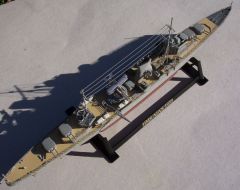 |
Ready to fire! |
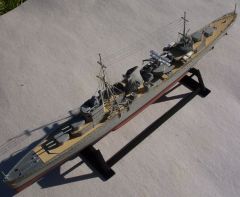 |
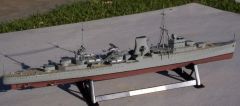 |
 | Seafox about to launch. |